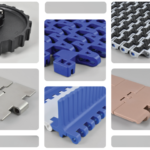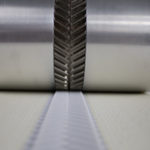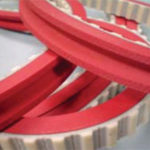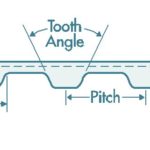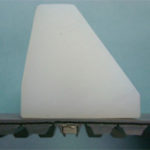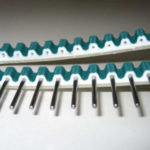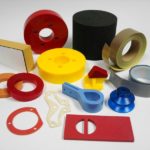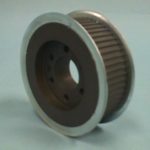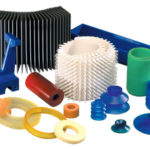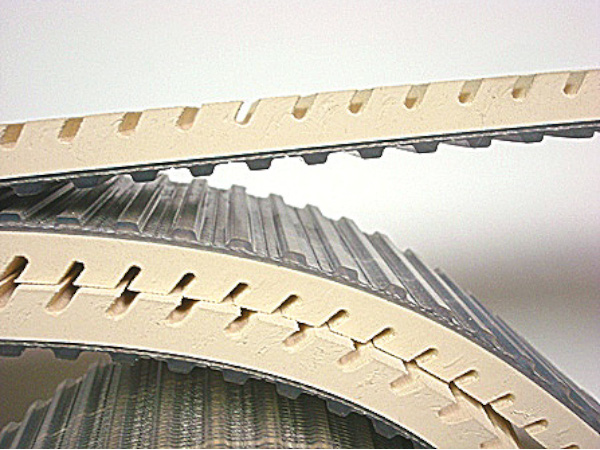
Urethane Casting
New to the process of urethane casting? Consider this.
According to ISQ Directory:
Chapter 1: What is Urethane Casting
“Urethane casting is the process of injecting polyurethane and additive resins into a soft mold usually made of silicone elastomer. The casting process is similar to injection molding; injection molding differs by using hard, metal molds. Urethane casting is usually applied on short-runs and low to medium volume production. This is due to the quick wearing of the silicone mold. However, the preparation of the silicone mold is cheaper and faster than making a metal tool, without sacrificing the final quality of the molded product.
“Castable polyurethane is a part of the polyurethane family that can be made into high performance, engineering grade products. Mechanical properties of cast polyurethanes can vary from being soft and flexible to hard and rigid materials.
Chapter 2: How Does Urethane Casting Work?
“There are four components to create urethane cast: the polyol compound, the diisocyanate compound, the chain extender or curatives, and the additives. The mechanical properties depend on the formulation of the prepolymer resin (the mixture of polyol and diisocyanate compounds) and the curatives. Additives are added to further improve the properties of the polyurethane such as resin curing time, machinability, color, UV protection and so forth. Additives are carefully proportioned relative to the resin mixture since it can weaken the urethane cast.
“The polyurethane reaction involves the formation of a simple polymer chain from the reaction of a polyol component (a carbon-chained molecule with alcohol on both ends) to a diisocyanate component (molecule with isocyanate on both ends). This results in a molecule with a reactive alcohol on one end and a reactive isocyanate on the other. The alcohol end further links to another isocyanate end or terminal, while the isocyanate end of the same chain further reacts with chain extender compounds (curatives such as hydroxyl and amines). This process continues making long chained polyurethane.
“Preparing the formulation can be done through different processes: single shot, prepolymer and quasi-prepolymer process. The single shot process involves having all components in separate chambers. These will then be blended by a mixing head and poured or injected into the mold. The prepolymer process, on the other hand, mixes the polyols and diisocyanates prior pouring into the mold. This process helps dissipate the heat produced from the exothermic reaction of the compounds. Last will be the quasi-prepolymer. Quasi-prepolymers consist of polyols partially reacted with the diisocyanate compounds. This simplifies the formulation process since the quasi-prepolymer are less viscous and require low processing temperature.
Chapter 3: The Urethane Casting Process
“Urethane casting is an easy, straightforward process. It only involves making the pattern, the mold, then pouring the resin. Below are the steps in making urethane cast products.
Master Pattern
“The most common process in creating a master pattern is by 3D printing, either by SLA (stereolithography), by PolyJet, or by FDM (fused deposition modelling). Other methods such as CNC machining may be used. Both methods start from making a CAD model of the part to be casted. In making the 3D model, it is important to keep in mind how the pattern will be molded and how the urethane cast will be removed. It is worth considering the following suggestions.
“Remove problematic features such as deep and narrow holes, internal cavities, and channels. These features can be added by secondary processes after the urethane part has been casted.
“Unlike die casting and injection molding, urethane casting does not require draft angles. Silicone molds are flexible and can be deformed to remove the molded product.
“Add gates and vents to the CAD model. The gates are where the resin and curatives will be injected; while the vents allow escape of air trapped inside the mold. The size and location of the gates depend on the volume and profile of the pattern.
“Section the model or separate its parts as needed. This depends on how much is the build volume of the 3D printer.
“Add locators on the mold to prevent any shifting of the mold halves. If there is shifting, the parting line of the molds will become significantly visible and the dimensions of the product will be off tolerances.
Choosing and Mixing the Silicone
“Silicone formulations usually come in as a viscous fluid of siloxane polymer which is then combined to a cross-linker and a catalyst. Creating a semi-solid from this siloxane fluid is usually done by two-component room temperature vulcanizing (RTV-2). This method is divided into two types: condensation cure and addition cure.
“Condensation curing uses organo-tin compounds as the catalyst. Polymerization is done by mixing the reactive component, the silane crosslinker and catalyst, and the unreactive component, the polymer and filler. This is the inferior method between the two since this curing process produces shrinkages of about 0.5% as the curing agent leaches out of the mold over time. Nevertheless, one advantage can be mentioned which is its resistance to inhibition. Inhibition happens when contaminants on the surface of the pattern prevents the silicone from properly curing. A common contaminant is sulfur that is usually found in modelling clays. If modelling clay is used for the master pattern, then condensation curing may be the better option.
“Addition curing is done by mixing the siloxane polymer and the platinum complex catalyst. This type of curing produces no by-products which in turn makes the mold odorless, has longer shelf-life, and is shrinkage free. They have better mechanical properties than condensation cured silicones but are critically sensitive to sulfur, phosphorus, arsenic, organo-tin compounds, PVC stabilizers, epoxy resin stabilizers and natural rubbers.
“Apart from two-component room temperature vulcanizing, there are other methods of polymerizing silicone such as one-component room temperature vulcanizing (RTV-1) and high temperature vulcanizing (HTV). With RTV-1, polymerization happens when the mixture of silicone fluid and cross-linkers is exposed to atmospheric humidity by undergoing hydrolysis. This process releases alcohols, acetic acid, ketones, and so forth. The release of these compounds produces the characteristic smell of the product. HTV, on the other hand, high-temperatures break down the peroxides into free radicals which cross-links the polymer. This process is also known as peroxide curing. The downside of HTV is the shrinkage of the silicone mold after cooling due to the high coefficient of thermal expansion of silicone.
“The elastomer components are then mixed in a container. This should be larger than the silicone volume to allow for expansion during degassing. Degassing is not required but is recommended to eliminate air bubbles caused by mixing. Bubbles trapped between the silicone and the surface of the pattern will cause bumps in the urethane cast. During degassing, the silicone mixture will rise until the air dispersed into the silicone is released. Afterwards, the volume will return to its starting level.
Creating the Silicone Mold
“The next step is to prepare the silicone mold. A mold box or a frame is prepared to contain the silicone while being poured. This is similar to a flask used in metal casting.
“The master pattern is placed in the mold box where the silicone and catalyst mixture are then poured. This process can be book mold, two-part mold, or skin mold. The book mold, or single stage mold, involves suspending the master pattern inside the mold box. The silicone is then poured into the mold box until fully covering the pattern. Once cured, the silicone block is then cut in half to remove the pattern.
“The two-part mold, on the other hand, has a predefined parting line on the master pattern. In this process, the mold box is filled with silicone only up to the parting line. After curing, the pattern is removed, and a second mold is prepared from the remaining of the pattern.
“Skin mold involves applying the silicone mixture by pouring it on the pattern layer by layer until a desired thickness is achieved.
“After curing the silicone mold, it is optional to apply a release agent before introducing the urethane. Release agent helps in the removal of the cast from the mold. Since silicone is flexible and does not readily bond with urethane, a release agent is not required.
Urethane Casting
“There are a variety of polyurethane resins available for casting, each with its own set of properties. Choosing the right urethane resins and curatives will be discussed in detail later. Once the silicone mold is prepared and the urethane resin chosen, casting is ready to begin.
“The casting process involves two liquids, the resin, and the curative, chemically reacting to form the shape of the pattern. Like the silicone, the resin and curative are mixed in a container and are degassed to remove any trapped bubbles dispersed in the mixture. The mixture is then introduced into the mold by pouring or by pressure fill. Pouring simply uses gravity to fill the void inside the mold, while pressure fill requires the use of equipment such as injection ram or screw-type plunger to push the mixture.
“Once the urethane is cured, the silicone mold is then split into its two halves and the cast is removed.
Secondary Operations
“Depending on the quality of the silicone mold, the urethane cast can have a smooth surface with minimal rough areas. Gates, vents, and flashings are cut and smoothened. Holes and channels not included in the master pattern are drilled or milled to complete the features of the product. One thing to remember while urethane cast machining is its susceptibility to melting. Machining must not be too aggressive, and the use of coolants is recommended.
Chapter 4: Mechanical Properties of Polyurethane
“Compared to metals and other plastics, urethane castings have its set of properties that makes them stand out. Below are some noted properties of polyurethane resins.
Abrasion Resistance
“Abrasion can be classified into two types: sliding and impingement abrasion. Sliding occurs when a soft and hard material slides or rubs into each other, with or without contaminants between the surfaces. Impingement abrasion, in contrast, happens when particles impact the surface causing erosion. Because of these properties, cast urethanes are excellent material for wheels and rollers.
“Cast urethanes with low coefficient of friction and high tear strength offer good sliding abrasion resistance. For impingement abrasion, cast urethanes with good resilience are used. Resilient polyurethanes can easily yield elastically. Forces from the impacting particles are easily distributed on the surface.
“Abrasion resistance is achieved by the right composition of the urethane resin. Among the polyol compounds for making polyurethane, polyesters exhibit better tear and abrasion resistance.
Impact Resistance
“Like abrasion resistance, urethanes possess good impact resistance because of its good resilience. Urethane castings can elastically deform to absorb the impact and return to its shape while dissipating the energy throughout the body.
Hardness
“Hardness is the relative resistance of a material to localized surface deformation. It is usually determined by measuring the depth of indentation on the material by a standard indenter, ball, or presser foot. Materials are then graded according to its relative hardness from one another. For elastomers, hardness is characterized by Shore hardness number as measured by a durometer. The Shore hardness scale is categorized into 12 scales, each scale has its own indenter configuration, profile and force applied. The most common scale for urethane casts are Shore A and D. Shore A scale measures hardness of soft, semi-rigid polyurethanes. Shore D, on the other hand, measures hard rubbers and rigid polyurethanes. However, keep in mind that high hardness does not correspond to high rigidity or strength.
Tensile Strength
“Elastomer tensile strength, like in metals, is the amount of force or stress the material can take without failing. Urethane casts can be formulated to meet strength requirements for up to 14,000 psi by using composite materials such as fiberglass and carbon fibers.
Flexural Strength
“For flexible urethane casts, flexural strength is a key property which tells how much bending force is required to break the material. Urethanes have excellent flexural properties, especially in thin cross-sections. They usually have 17,000 psi flexural strength, up to 39,000psi for composite casts.
Chapter 5: Urethane Casting Materials
“As mentioned before, urethane resins are made of four components. Out of these four components, three influence the final mechanical properties of the product. There are a number of formulations possible that serve a specific application. Below are the urethane resin components, its types, and the properties they impart on the product.
The Polyol
“A polyol is an organic molecule containing one or more hydroxyl (OH) groups. Polyols used in urethane casting are either polyether or polyester types.
Polyether
“These are made by the reaction of organic oxides and glycol. Polyethers are characterized for having good resilience, high impact resistance, low heat build-up for dynamic applications, hydrolysis resistance and good low temperature performance. Common types of polyether used in the polyurethane industry are PTMEG and PPG. Between the two, PTMEG offers superior quality but is more expensive.
Polyester
“These are made by the polycondensation reaction of diacids and glycol. Compared to polyethers, polyesters have good abrasion resistance, heat aging resistance, oil resistance, solvent resistance, good shock absorption properties, and better tear resistance.
Specialty polyols
“The most common are polycarbonate and polycaprolactone polyols. These two polyols are also sometimes classified as polyesters. Polycarbonates are used as engineering materials due to their strength and toughness. Polycaprolactone, on the other hand, gives the cast urethane good water, oil, solvent, and chlorine resistance.
The Diisocyanate
“Like the polyols, diisocyanate compounds form the resin side of the polyurethane system. There are two main types of diisocyanate: aliphatic and aromatic.
Aliphatic Diisocyanates
“This type’s most popular characteristic is its non-yellowing appearance. Also, they have lower reactivity which makes them useful for chemical resistant coatings. Aliphatic diisocyanates are mostly used in polyurethane coatings, films, and castings where color stability is required. The most common ADIs are hexamethylene (HDI), hexamethylene (HMDI), and isophorone (IPDI).
Aromatic Diisocyanates
“This type is further divided into NDI, TDI and MDI.
Naphthalenic Diisocyanates (NDI)
“This type is extensively used in Europe as compared to the TDI and MDI dominated American market. NDIs are known to offer superior performance and long service life for dynamic applications. One downside of using NDIs is its high melting point making it difficult to process. Moreover, it is highly reactive resulting in lower storage stability. Thus, it is usually manufactured by special equipment at the custom molder.
Toluene Diisocyanate (TDI)
“This type is popularly used for high hardness applications such as guide rollers, in contrast with MDIs. Typical forms of TDIs used in an industrial scale are the 2,4 and 2,6 isomers at 80/20 blend. Producing different proportions other than the 80/20 require additional process.
Methylene Diphenyl Diisocyanate (MDI)
“MDIs are known for imparting high resilience and impact strength to urethane casts. That is why MDIs, paired with either polyethers or polyesters, are used in dynamic, high impingement applications such as wheels, construction panels, automotive bumpers, and the like. The most common isomer used in casting is purified 4,4 isomers.
Curative
“Curatives are mixed with the polyol and diisocyanate prepolymer to form a solid or semi-solid elastomer. There are two basic types of curatives: hydroxyls and amines.
Hydroxyls (Diols)
“These curatives have hydroxyl groups (OH) at the molecule terminals that link prepolymers. The standard hydroxyl curative is 1,4-butanediol (BDO) commonly used in MDI prepolymer systems at room temperature.
Amines
“Aside from hydroxyl groups, amine groups (NH2) can also bond on the terminals of the prepolymer. The widely used amine curative is 4,4-methylenebis (2-chloroaniline) or MOCA as the base curative for TDI prepolymer systems. However, this type was then identified as a carcinogen by OSHA. Other amine chain extenders are now being used such as 4,4-methylenebis (3-cholro-2,6-diethylaniline) (MCDEA).
Chapter 6: Benefits of Urethane Casting
“Mentioned below are the main advantages of using urethane casting in contrast to die casting and injection molding.
Low Investment Cost
“As mentioned earlier, urethane resins can be cast by soft molds such as silicone. Silicone molds are made easier and less expensive than metal tools or molds. This creates an option for producing cast prototypes making any modification cheaper. It also does not need expensive equipment such as injection pumps, heaters, kneading machines, and so forth.
Quick Production Runs
“Urethane molds can be created within three days as compared to hard molds that may require a week or two. Master patterns and silicone molds are easy to fabricate making it suitable for pre-production runs that are usually on trial and error. Product design becomes much faster before transferring to hard tooling.
Ease of Processing
“Urethane casting is preferred for backyard, do-it-yourself projects because of the simple equipment required. At most, one will need a few containers, a weighing scale, an air compressor, a mixer, and a spatula. Silicone molds can be prepared at atmospheric pressure and temperature conditions. The urethane resin on the other hand, usually requires some heating to lower its viscosity, hasten the curing process, or melt the solid or semi-solid components.
Wide Range of Physical Properties
“Polyurethane systems, with its different types and proportions of polyols, diisocyanates and curatives, can have almost any property to suit a particular use. It can be formulated for hard, tough, high-performance parts such as wheels and rollers; or, for soft, shock-absorbing applications such as impact absorbing pads and cushions. There are different formulations available in the market each with its own intended usage.
Chapter 7: Applications of Urethane Casting
“Because of its wide array of properties, cast urethanes are found in every industry. Urethanes are versatile materials that can be manufactured easily with low initial costs. Below are popular applications of urethane casting.
Product Design
“As mentioned earlier, prototyping or product design is one of the main applications of urethane casting. Urethane castings can conform to any design due to its easy to customize properties.
Wheels and Rollers
“Due to its toughness, high impingement resistance, shock absorption and fatigue resistance, urethane resins are a popular choice. Urethane castings can be seen on caster wheels, pulleys, guide rollers, and so forth.
Automotive Vehicles
“Urethane castings can be formulated as shock and vibration resistant which makes them suitable for automotive applications. Moreover, they can withstand high temperatures replacing steel.
Shock Absorbers
“High vibration from rotating equipment causes rigid materials to crack. Urethane castings can be made to absorb vibrations as seen from shock absorbers and dampers.
Medical Device Components
“There are urethane formulations available that are FDA compliant. Medical devices serving a niche purpose or have a unique design usually requires low volume production. This makes urethane casting a suitable method of production.
Consumer Products
“Because of its wide range of properties, urethane castings can be used in many consumer products. Examples of these are shoe soles, sports equipment, electronics casings, and so forth.”
